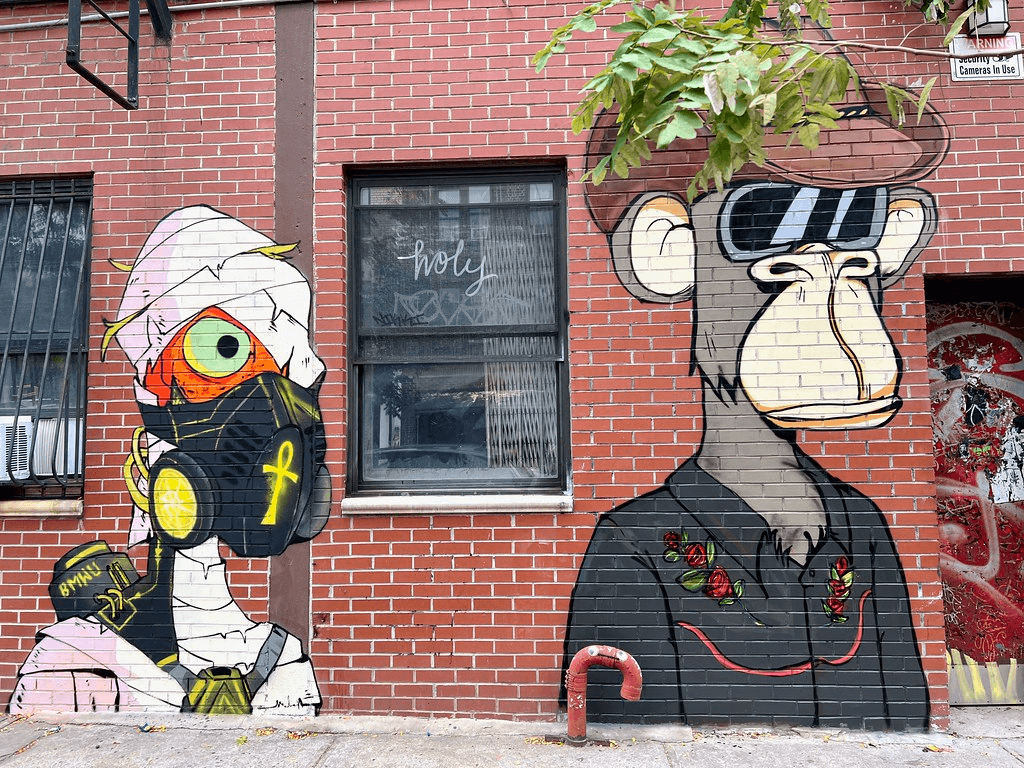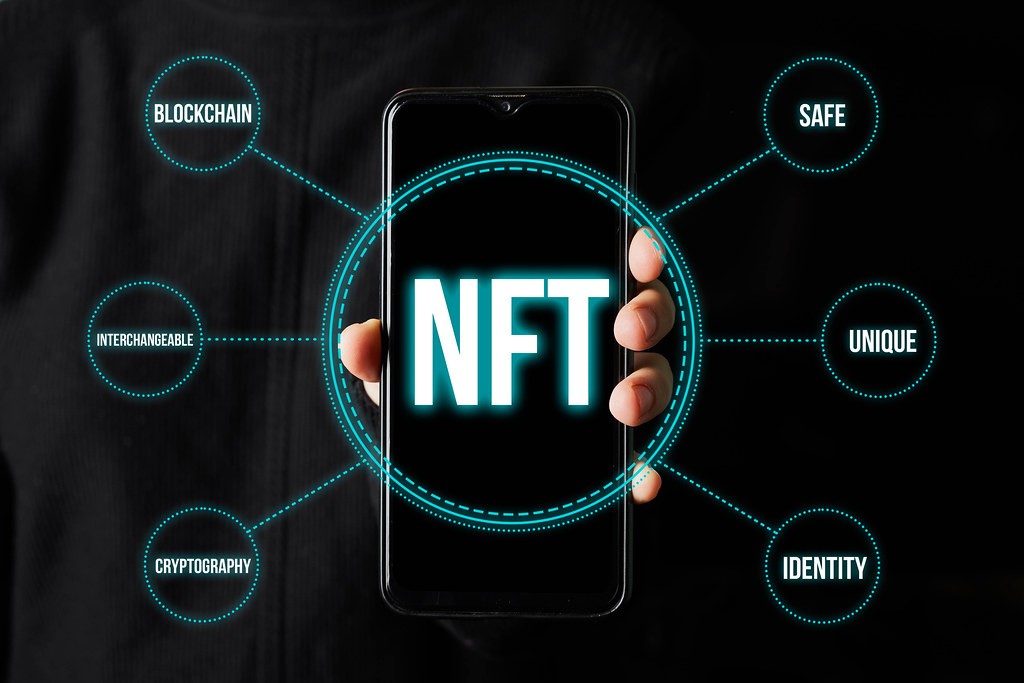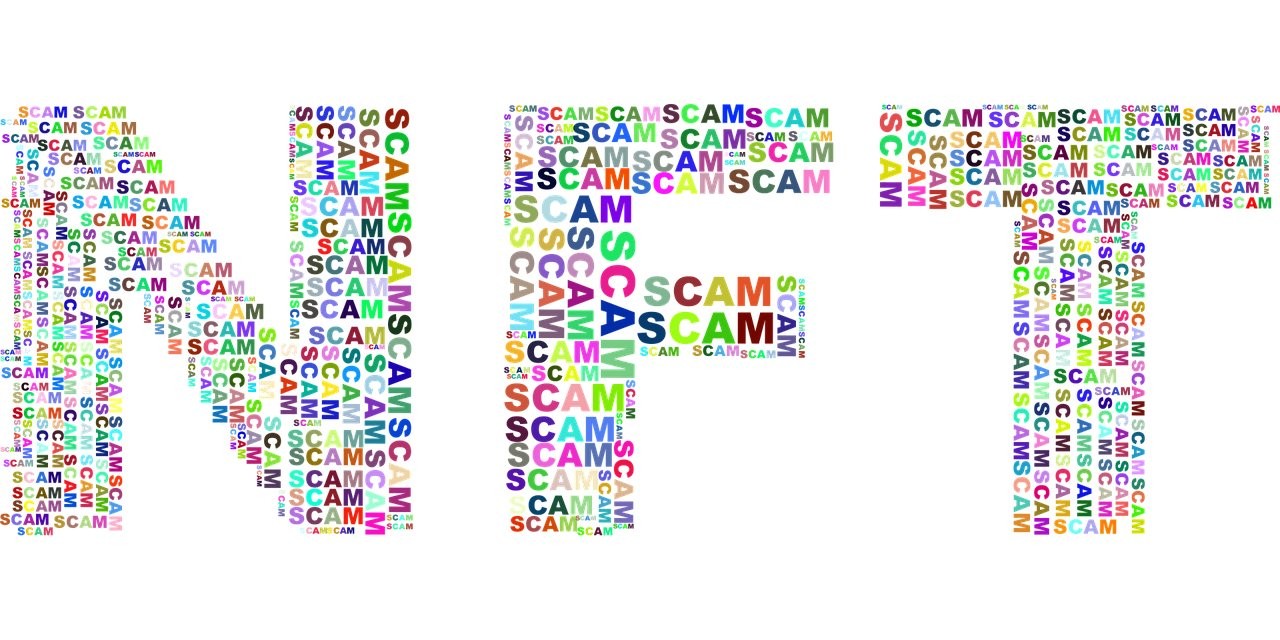How is your
website's SEO?
Use our free tool to get your score calculated in under 60 seconds
- Home
- /
- Blog
- /
- Logo Design
What Is NFT And How Does It Work – A Comprehensive Overview
How is your
website's SEO?
Use our free tool to get your score calculated in under 60 seconds
By John Fernandes on May 09, 2022
~ 2 minutes to read-
Share on
-
Share on
-
Share on
Since we are tech-savvy and digitally social, we start sharing many parodies, infographics, jokes, artwork, as well as other digital products with our family and peers for enjoyment, information, or to make people aware of some event.
But have you ever wondered who created those assets or where that digital property actually came from? Non-fungible tokens are the answer to these debriefs.
It all started in 2017, when Crypto Punks, the first non-fungible token, was released on the Ethereum Blockchain by the American studio Larva Lab. At the time, the team consisted of John Watkinson and Matt Hall. In the same year, another project called Crypto Kitties was released, and it went viral almost immediately. It is expected to bring in $12.5 million in investment.
In this article, we'll look at non-fungible tokens, including what they are, how to get started with them, and how they grew in popularity. We'll also look at how to create non-fungible tokens, the characteristics that distinguish them, their benefits, risks, and the future.
What exactly is NFT?
Non-fungible asset tokens are distinct digital assets whose possession can be traced using NFT blockchain development platforms such as Ethereum. Fungible assets, also known as fungibility, are items or assets that can be traded or swapped for a similar asset class or good.
NFTs, or Non-Fungible Tokens, are digital assets or a type of digital certificate for owning goods or an asset that represents a wide range of intangible and tangible items such as portraits, virtual property investment, postcards, and videos Because each non-fungible token asset is unique in its own right, NFTs cannot be replicated or equated with a similar asset. More information on the development and cost of the NFT marketplace can be found here.
Let's look at an example of a game ticket to help you understand. If you were given a baseball game ticket, you would obviously take the baseball game ticket. Right? Would therefore you embrace a cinema ticket in exchange for someone returning it to you?
The answer is no because a movie ticket is not worth the same as a baseball game ticket. If we use this example instead of NFT, we can see that the game ticket (which is an NFT) cannot be replaced or traded with any other ticket because each baseball game ticket has its own distinct identity.
The same is true of NFT tokens, which cannot be exchanged or traded with tokens of similar value because each token is distinct and has its own rarity and uniqueness.
Examples of Non-fungible Tokens

The advantages of owning a digital collectible over a physical collectible like a stamp or rare coin are numerous. Each NFT contains distinguishable information that distinguishes it from other NFTs and facilitates the verification of a collectible's authenticity.
For example, it renders the circulation of fake collectibles pointless for an artist because the original item can be traced back to its legal owner. You can't exchange NFTs directly with anyone, unlike other NFT cryptocoins, for the same reason – they're all non-identical/dissimilar. Even if two NFCs on the same platform are part of the same collection and have the same size and colour, they will not be identical. Let's look at some NFT project examples:
Blockchain Heroes is an original trading card series that highlights the similarities between crypto and blockchain personalities.
Decentraland– In this game, players can purchase the virtual worlds that other players own. The virtual space owner can monetize their world by setting up shops, advertising, and so on.
Prospectors.io is a blockchain-based game in which players receive their owned assets in the form of blockchain and earn NFT based on their gameplay.
Gods Unchained is a digital or online collectible card game in which the cards are in the form of NFTs that can be freely bought and sold.
CryptoKitties is a well-known NFT game in which players breed and collect cats. These virtual cats made famous NFTs by assigning unique "cattributes" to each token.
NFT's Origins: How and Why Did It Begin?
There are some debates about when NFTs first appeared. The first NFTs are thought to have been coloured coins. Colored coins are blockchain representations of real-world assets.
Colored Coins were first mentioned in a blog post by Yoni Assia in early 2012, titled "bitcoin 2.X (aka Colored Bitcoin) — initial specs." Colored Coins are said to have encouraged experimentation and paved the way for NFTs.
Then came the trading of Rare Pepes on Ethereum, followed by the release of Crypto Punks, the first-ever NFT Token.
Following that, Rare Bits, a marketplace and exchange portal for NFTs, was founded and raised $6 million in funding. The NFTs' ideology enabled the creation of a collectible card game known as Gamedex, which raised over $800,000 in its first days. Beeple, a digital artist from the United States, recently released his work "Every Day."The First 5000 Days," which fetched $69 million (42329.453 ETH). It's one of the first NFT works to be listed in some of the world's most prestigious auction houses.
In addition, NBA and Dapper Labs recently announced a partnership to launch the beta version of NBA TopShot Collectible and Tradable NFT-based apps. They started working on it in 2018, and it was released in the first half of 2020. In the form of packs, the collectible contains tokens with data and multimedia mashed together.
The Reason for NFT's Surge in Popularity

NFTs have been used in a variety of industries over time, and they're now known as Ethereum Tokens based on ERC-721. NFTs are trendy these days for a number of reasons, including:
• The entire data of NFT is securely stored in Blockchain, ensuring that the tokens can never be removed, destroyed, or replicated.
• The scarcity of NFTs is their primary source of value. Although NFT developers have the ability to create an infinite number of tokens, they are intentionally limited in order to maintain their value.
• NFTs are completely indivisible, which means they cannot be divided into smaller denominations like Bitcoins.
• Because of Blockchain's capabilities, NFTs can be easily tracked back to their true owner, eliminating the need for third-party verification forever.
*Fun Fact* Bitcoins are completely fungible, which means they can be traded without losing their value. Unlike traditional cryptocurrencies like Monero, Ethereum, and Bitcoin, NFTs cannot be directly exchanged.
What Are the Advantages of Distant Non-Fungible Tokens?
1. Incompatibility
NFTs are considered non-interoperable because they follow the ERC-721 standard, which means the information stored in them cannot be exchanged or used in any way.
2. Uncommon
The total number of NFTs in the world is currently very low, and they are extremely rare. This makes them not only uncommon, but also valuable. Basically put, the lesser the NFs, the higher the cost.
3. It's unbreakable
The NFTs are stored and managed using Blockchain, which gives them a higher level of security. They can never be destroyed or removed for any reason.
4. Indestructible
Because NFT cryptocoins are non-fungible and have no defined value, you can't send a portion of them to anyone (unlike other cryptocurrencies). For example, one bitcoin will retain its value after transfer, but NFT will not.
5. One-of-a-kind
NFTs use blockchain to differentiate themselves from the crowd and determine the authenticity of a work of art. It also allows you to distinguish between original and duplicated items.
The NFTs' Working Methodology
NFTs are one-of-a-kind blockchain-based crypto tokens. As a result, blockchain serves as a decentralised ledger that tracks each NFT's ownership and transaction history, as well as other metadata that no other token can duplicate.
What exactly are non-fungible tokens, and how do they function? Consider the following to find an answer:
With the right tools and support, the process of creating NFTs can be done on contract-enabled blockchains. Ethereum was one of the first widely used EOS, and it now includes NFT standards as well. Tokens and smart contracts allow for the addition of detailed information such as the owner's identity and so on.
When combined with digital media, this process gives NFTs the characteristics of scarcity and royalties that make them appealing:
Scarcity
When we talk about scarcity, we mean that the owner of the asset gets to decide how scarce it is. Contemplate a ticket to a sports competition or a concert: the owner decides how many tickets will be sold. In the same way, the creator of the NFT token market can decide how many replicas are needed. As a result, these replicas exist, each with a slight variation.
Another example of how to make non-fungible tokens is when the owner can only make one NFT token, making it a rare collectible. In any case, each NFT will have its own distinct identity, such as a bar code on every cloth or ticket that appears to be identical but is not.
Royalties
NFTs are coded with software code (known as smart contracts) that enforces elements such as NFT transferability and ownership verification. Also, like any software application that includes a variety of applications and functionality, NFTs can be programmed beyond the basics of ownership and transferability (which also involves the linking of NFT to other digital assets).
For example, a smart contract could be written so that some NFTs automatically allocate a portion of the proceeds from any NFT sale to the original owner, effectively paying royalties.
When someone creates an NFT, they are writing the smart agreement code that governs the non-fungible tokens' properties, which is then added to the blockchain where the NFT is managed. NFTs can be handled by a variety of blockchains, including Ethereum (which uses the ERC-721 and ERC-1155 smart contract principles), Flowchain, and Wax, which all use similar processes. Certain NFT marketplaces, for example, work with specific blockchains, so the blockchain chosen for NFT can have real consequences for the seller if proper decisions are not made.
Use Cases for Non-fungible Tokens in a Variety of Industries
1. Video games
The majority of games have a virtual currency built into their ecosystem to aid users in their progress. In an ever-expanding unregulated market, accounts with multiple purchased commodities are in high demand. Players will be able to easily trade in-game collectibles with proper validation and security thanks to the various uses of NFTs.
2. Digital Resources
NFTs are an excellent choice for digital assets such as house plans, mock-ups, themes, and domains. Furthermore, digital real estate is becoming increasingly popular in games like Decentral Land. They allow players to buy and develop a virtual world's worth of spaces. The addition of NFT ensures that the items' original creators can be identified.
3. Theft of Identity
NFTs can be used to prevent identity theft in things that represent identity and can be digitised, such as medical records and academic qualifications. Furthermore, digital artists can use non-fungible tokens to convert their artworks and establish unique copyright for them, demonstrating the importance of non-fungible tokens. It also facilitates in distinguishing genuine from counterfeit items.
4. Digital Artifacts
It goes without saying that NFTs are rare, and they're mostly used in collectibles and art. The authenticity and ownership of a collectible or artwork can be easily verified with the addition of this token. This also protects an artist's work from being pirated or misappropriated. NFT is already being used in greeting cards and merchandise.
5. Validation and Identification
NFTs ae programmed with a unique set of information about an asset or a good. As a result, they're ideal for issuing certificates, identities, credentials, and licences. To make it traceable back to the source, the identification or certification can be issued directly through the blockchain as an NFT.
When we understand the concepts of NFT, we can see how a blockchain of smart contracts can be a powerful force for change.
Benefits of Non-fungible Tokens
Rights of Ownership
Non-fungible tokens have advantages that can be used to address something extraordinary in both the digital and real worlds. This has been used in the digital world for collectibles and gaming (to show that someone owns a specific CryptoKitty or item), but it could also be used in the real world for unique items like houses, vehicles, craftsmanship, or even personalities. It could also be used to grant restricted access, such as to Airbnb on specific dates or to purchase airline tickets.
Approach to Customization
The Benefits of Non-fungible tokens, unlike fungible tokens, are secure. Some operations of non-fungible tokens may be performed by smart contracts and fungible tokens. In the non-fungible token market, however, the token itself holds all of the information.
Additional data can be assigned to the token, including standard options like name and ownership, as well as areas like the token's history and related data. Such as an image of the house, the token representing previous owners of a vehicle the token represents, or the number of character skins in a game with a similar model type the token represents.
Trade Security
In general, the importance of non-fungible tokens can be seen when transferring ownership of physical or digital items is vulnerable to fraud, and as a result, is either difficult to carry out or outright forbidden. Exchanging anything addressed by the token would be a much less complex and effective process thanks to the security of blockchain and the uniqueness of non-fungible tokens. As a result, it may be possible to transfer ownership of items across platforms or even be interoperable across different services such as games or NFT marketplaces.
When it comes to the characteristics of NFT, there are a variety of them. Every benefit has risks that must be considered in order to demonstrate it.
The Consequences of NFT
Valuations
If you're wondering where to buy NFT, look no further. Then you should be aware that, like any collectible, purchasing an NFT is a risky bet with its value rising. Unlike Blockchain asset tokenization trading cards or purchasing a real asset, NFTs are a new market, so there is no guarantee that demand for digital assets will be similar.
If there is no demand for the NFT you purchase, you risk paying an exorbitant price for something that depreciates in value or is simply unsellable. You could also make your own NFT, but there is no guarantee that it will sell, resulting in a waste of time and money.
Storage
NFT sales are tracked using blockchain technology, which proves ownership. Marketplaces and platforms like Open Sea and Rarible are where real NFTs are created and stored.
If these platforms are shut down, there is no guarantee that you will still be able to access the work. This makes it less secure than physical art on a wall, gaming tickets, or trading cards that aren't going to vanish.
Regulation
Because NFTs are not regulated, a high level of trust is required. You must believe that the NFT you are buying is a one-of-a-kind piece of art or work that hasn't been duplicated elsewhere, or you risk a copyright issue.
Also, if regulators and administrators become concerned about this thriving industry, platforms may face restrictions and collector contributions may be limited. This could lower the market value of the NFT token.
Effect of Hot Potatoes
NFT games can be "hot potato" situations. The players buy an asset in order to sell it for a profit, but if the market crashes, they could lose a lot of money.
For example, suppose you own a gaming sword and want to sell it for a higher price than before. Now, as long as someone is willing to buy, you will profit; however, if no one is willing to buy the non-fungible asset or if the market collapses, you will lose money.
NFTs' Future

Whatever the risks, NFTs have a bright future ahead of them, as the total market for them is expected to reach $100 million by the end of July 2020. Experts in the crypto industry predict that NFTs will be the entry point for 40% of new crypto users.
With the decentralised finance industry now worth over $4 billion, it's clear that the NFT space is set to explode in the coming years.
NFT Frequently Asked Questions
O1. What exactly is NFT cryptography?
Non-fungible Tokens, or NFTs, are digital assets or a type of digital certificate for owning goods or an asset that represents a wide range of intangible and tangible items, including portraits, virtual property investment, postcards, and videos
Q2. Where can I get NFT?
Ans. You can purchase them from a variety of online marketplaces. OpenSea is a significant company. Consider it a virtual gallery where you can peruse digital art, trading cards, and other collectibles.
Q3: How do I get started with NFT?
Ans. If you want to invest in NFT, you will need a cryptocurrency such as Ethereum (ETH) or Bitcoin. Once you have the cryptocurrency in your wallet, you can use sites like Rarible or SuperRare to find and purchase the best digital artwork.
Q4: What exactly is an NFT art?
NFT art can be any type of digital file, including artwork, articles, music, and memes.
The Conclusion
It's possible you've already deduced that it's still in the early stages of development. As a result, numerous cutting-edge platforms based on NFTs are likely to emerge in the coming years.
In terms of the present, Crypto Kitties and gaming are giving way to digital identity, painting, and other non-fungible token use cases. This means that in terms of experimentation, the market is still in its infancy. This would mean a plethora of opportunities for a new-age entrepreneur to enter and dominate the space blockchain development services sector. We are here to assist you. Send us your NFT-based project ideas.

John Fernandes
John Fernandes is content writer at YourDigiLab, An expert in producing engaging and informative research-based articles and blog posts. His passion to disseminate fruitful information fuels his passion for writing.
